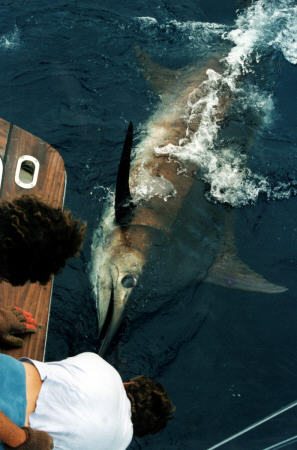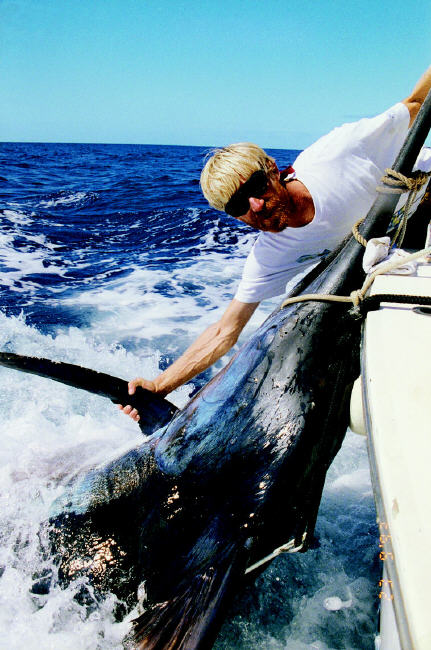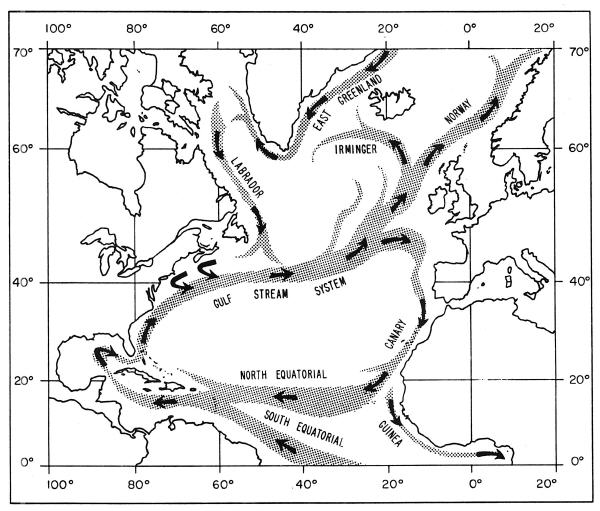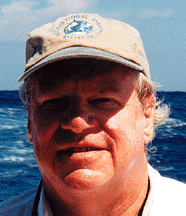 |
 |
 |
 |
 |
 |
 |
 |
 |
 |
 |
 |
 |
 |
 |
 |
 |
 |
 |
 |
 |
 |
 |
 |
 |
 |
 |
 |
 |
 |
 |
 |
 |
 |
 |
 |
 |
 |
 |
 |
 |
 |
 |
 |
 |
 |
 |
 |
 |
 |
 |
 |
 |
 |
 |
 |
 |
 |
 |
 |
 |
 |
 |
 |
 |
 |
 |
 |
 |
 |
 |
 |
 |
 |
 |
 |
 |
 |
 |
 |
 |
 |
 |
 |
 |
 |
 |
 |
 |
 |
 |
 |
 |
 |
 |
 |
 |
 |
 |
 |
 |
|
The following article was
originally published in the Big Game Fishing Journal in its July/August 2001 issue, a special annual issue on marlin. The BGFJ website can be entered
here. |
|
|
|
Grander Hunting |
|
|
|
by Jim Chambers and Capt. Joseph Franck |
|
|
Where Should You Go for the Best Shot at a 1,000-Pound Plus Atlantic Blue Marlin? |
|
|
|

Our answer? the Azores
and here's why ...
A Grand Release: Would you release the world record Atlantic blue marlin?
Pictured at
right is an estimated 1,400 pound Atlantic blue marlin caught but released
in good shape by Captain Joseph Franck for angler Peter Ganz, knowing it was well beyond the 80-pound line class world record (then 1,189 pounds)
and possibly a new 130-lb and all tackle world record blue marlin (1,402 lbs).
Because of its size, speed and spectacular jumps, many big game fishermen consider blue marlin the top prize in the saltwater angling world. So, where can you go to do battle with a very large blue - one weighing over 1,000 pounds? For the last three years, the large ones seem to have all but disappeared. Traditional, Atlantic marlin "hot spots" keep reporting fishing as "really slow." And there is, after all, good scientific evidence that international commercial fishing fleets targeting swordfish and tunas have in the process reduced both Atlantic-wide white and blue marlin populations to dangerously low levels. (See
www.BigMarineFish.com/marlin.html for details. - Ed.) But, worldwide climate shifts, particularly El Nino and La Nina, have also played a big role in determining where marlin are found.
With the 1997-1998 warming of the tropical Pacific and Indian Oceans, referred to as El Nino, followed by two successive years of colder than normal water, called La Nina, oceanic water temperature patterns were drastically changed, worldwide. In 1997 and 1998, large areas of the North Atlantic Ocean were also much warmer than normal. La Nina resulted in broad expanses of colder than normal ocean waters in the Atlantic (and elsewhere) for the past two years. As we all know, fish are very sensitive to even small changes in temperature, and will move great distances to maintain their preferred temperature zones. The large areas of warmer water followed by substantial periods of colder water have re-distributed both predators and prey (such as concentrations of smaller tunas, mackerel, squid and a large number of other species) on which billfish and the other large pelagics depend. As a result, hook-ups declined dramatically at the usual fishing destinations beginning in 1997 and continuing through most of 2000. The good news from the scientific community is that La Nina officially ended in late 2000. The world's oceanic temperature patterns thus appear to be returning to "normal." Therefore, we should expect to find the great ocean predators at their usual haunts. Moreover, we should also expect several years of stability in ocean temperature patterns and "normal" fish distribution since El Nino seems to return on roughly a seven-year cycle, meaning the next might not begin until 2004. |
|
|
|
|
|
|
So, Where Should You Go for a Grander? |
|
|
|
The quick answer is, "Where there is a history of catches of very large blues
(like the 80-lb line class world record - 1,189 lbs - pictured below right)." The Azores provide the one place in the entire Atlantic Ocean where serious anglers and crews have a good possibility of hooking the very largest blue marlin - fish weighing at least 700 pounds and as much or more than the current IGFA all tackle world record of 1,402 pounds (caught off Vitoria, Brazil, in 1992) - as well as grander bluefin tuna. Ocean where serious anglers and crews have a good possibility of hooking the very largest blue marlin - fish weighing at least 700 pounds and as much or more than the current IGFA all tackle world record of 1,402 pounds (caught off Vitoria, Brazil, in 1992) - as well as grander bluefin tuna.The best-known billfish destinations in the Caribbean region (such as the North Drop off the Virgin Islands and the extension of this wall off Puerto Rico, or the famed La Guaira Bank off Caracas, Venezuela) can't compare to the Azores in terms of the size of fish encountered. For example, the first grander ever landed in Puerto Rico was taken just this year. Large blue marlin are also caught occasionally in the Bahamas, the northern Gulf of Mexico, and along the East Coast of the United States, particularly off Cape Hatteras.
On the eastern side of the North Atlantic, catches of very large blues have been made off Madeira, the Cape Verdes and, as we will show below, the Azores. Additional prime blue marlin fishing destinations now include Brazil and most recently, Ghana
in West Africa and Ascension Island - like the Azores, a volcanic island
bathed by major currents in the middle of the South Atlantic on the flanks
of the Mid-Atlantic Ridge.
But the important point to
consider is that record size blue marlin (and the other big fish) spend
literally months (summer through fall) feeding in the area of the Azores
(where prey is abundant), whereas they simply migrate through the other
Atlantic "hot spots" on their way to and from their Caribbean spawning grounds and so
are available relatively briefly elsewhere.
What Brings Them There?
It's the currents, particularly their edges, which these fish are following. Unfortunately, so are the swordfish and tunas, which commercial fishing fleets are targeting.
In the North Atlantic Ocean, adult marlin and swordfish spawn in the tropics (particularly
the gaps between the Caribbean
Islands) in the spring, and once done move rapidly north as the ocean warms in the late summer and fall until winter drives them south again.
Pictured below is a chart of the North Atlantic's major surface currents.
Following spawning, the
big fish follow the Caribbean Current through the Caribbean Sea into the Gulf of Mexico. It circles the Gulf (clockwise) as the Loop Current and exits between Cuba and Florida as the Gulf Stream. It is immediately joined by the Antilles Current, which passes north of the Caribbean island chain and over the Puerto Rico Trench (one of the deepest points in the Atlantic ocean). The large pelagics follow the Gulf Stream as it flows northeast from Florida, along the edge of the U.S. continental shelf (including Georges Bank) then east to the Grand Banks, Flemish Cap and beyond (site of the movie The Perfect Storm) toward Europe.
At about where it
meets the Azores, the Gulf Stream splits. One branch continues on to the north giving welcome warmth to the British Isles and Iceland. The other bends
east and south as it passes beyond the Azores, then along Portugal and Spain
and heading toward North Africa. Here it loses heat (and is now called the Canary Current) as it bathes
first Madeira and then the Canary Islands. Off the northwest coast of Africa it veers back to the west passing
through the Cape Verdes Islands and picking up tropical heat as it returns to the Caribbean region as the North Equatorial Current, thus totally circling the Sargasso Sea. These currents are caused by surface winds, heated by the Sun, and the Earth's rotation. |
|
|
|
|

|
|
|
At 30 degrees
W and 40 degrees N, the Azores are positioned directly in the path of the Gulf Stream, which acts as a
giant conveyor belt bringing warm water, major upwellings, a profusion of
smaller fishes and drawing big marlin, tuna and
sharks from summer through fall. |
|
|
|
Apparently, billfishes' prey (e.g.,
tunas and squid) is concentrated along the major surface currents' edges, particularly where large eddies break off and move against the edge of a continental shelf or islands
like Barbados, Hawaii or the Azores. Longliners know to set their baited lines along the exact edge of these water masses where the temperature can change several degrees within a few feet. Satellite imagery can be used to locate this prime site for big fish: the leading edge of these large eddies, especially if they are moving against the continental slope (generally between the 100- and 1,000-fathom depth contours). |
|
|
|
Spawning Sites |
|
|
|
Critical habitat for Atlantic billfish (blue marlin, white marlin, sailfish, swordfish
and probably spearfish) includes not only the edges of the major currents, but also these fishes' spawning sites, which are surprisingly small and specific. We know some of their locations because this is where longline vessels catch the greatest number of billfish during the late spring and early summer when the adults are spawning. The most important sites in the North Atlantic include the large passes between the Caribbean islands of the Greater and Lesser Antilles, and particularly two large areas well out into the Atlantic (along major currents) east of the Virgin Islands and another east of Barbados. (See
www.BigMarineFish.com for maps of the spawning, nursery and feeding areas of swordfish,
blue marlin, white marlin, bluefin tuna and sailfish.) |
|
|
|
Commercial fishing should be prohibited by international agreement to protect all important spawning sites. This will require the big game fishing community to pressure the political leadership, particularly in the United States, to aggressively seek such agreements by the responsible body, the International Commission for the Conservation of Atlantic Tunas (ICCAT) and its 31 member nations. However, first we must protect the critical habitats located in U.S.-controlled waters. |
|
|
|
Nursery Areas |
|
|
|
Nursery areas are waters located "downstream" from the spawning sites. Larval billfish spawned in the two largest spawning sites, those located east of the Caribbean chain of islands, are carried by the prevailing currents in two directions: into the Caribbean along the coast of Venezuela and northwest as the Antilles Current toward the Bahamas and Florida. Consequently, the shelf off Venezuela provides year-round nursery habitat for young marlin
and swordfish spawned in the Atlantic well east of the Lesser Antilles. So too, the northern Caribbean Sea is a year-round nursery area for those fish spawned in the largest passages between the Caribbean islands such as Cuba, Hispaniola and Puerto Rico. The northern and eastern portion of the Gulf of Mexico and lower East Coast of the United States (along the edge of these currents) provide nursery grounds for fish spawned in the Caribbean (particularly the Yucatan Straits between Cuba and Mexico), off the Virgin Islands and Puerto Rico and off the Florida Keys and southeast Florida. |
|
|
|
Feeding Grounds |
|
|
|
Young billfish appear to remain in the tropics year-round for several years or until they grow large enough to tolerate colder water temperatures where prey is (or was) more abundant. (As a general ecological principle, the tropics support greater numbers of species but fewer individuals of each, whereas northern waters, which are colder, but more productive, support many more individuals, but fewer species.) That's what draws the very largest adults to their most northerly fall feeding grounds off New England and Nova Scotia for giant bluefin tuna (which spawn in the Gulf of Mexico), the edge of the continental shelf from Cape Hatteras to Georges Bank for white and blue marlin, the Grand Banks and beyond for swordfish, and the Azores for all four species. |
|
|
|
Thinking Like Big Fish |
|
|
|
So, now we see why traditional big game fishing destinations have developed their reputations. And the basis for their different "seasons." The Caribbean region and gaps between the various islands should be most productive for adults from late spring through early summer. After spawning, they move north along the edge of the continental shelf for better feeding opportunities typical of colder waters. For the remainder of the year, the Caribbean is the home of the juveniles. Some adult billfish move from the Caribbean to the northern Gulf of Mexico for their fall feeding period. A larger group of white and blue marlin follows the Gulf Stream. They can be found during late summer and fall from Cape Hatteras to the eastern tip of Georges Bank. As we will show below, a number of very large blue marlin, and in unusual years very large bluefin tuna, are found in the Azores during the fall. Sailfish range the least, staying closer to their prime spawning site in the Straits of Florida, while swordfish appear to range the farthest. |
|
|
|
They are all finally driven from their prime feeding areas at the northern end of their ranges by the onset of winter (by November). Based on tag results, many return to the tropics along the same route they just followed (i.e., along the edge of the continental shelf and the edges of the major surface currents) probably following the availability of prey. But others, perhaps the largest individuals, may follow the North Atlantic current system to entirely circle the Sargasso Sea. All arrive in the tropics at the right time to join the others for spawning - just like salmon returning after thousands of miles to the very stream where they began life. We may never understand how any of these fish can accomplish such an astounding navigational feat. |
|
|
|
Big Fish Conveyor Belt |
|
|
|
The nine volcanic islands of the Azores are pinnacles rising steeply from the deep ocean floor along the shoulder of the mid-Atlantic Ridge. This is the split down the middle of the Atlantic Ocean where the continental plates have been
dividing and drifting apart for centuries. Fortunately, the Azores are positioned right in the path of the Gulf Stream. And it acts as a huge "conveyor belt," bringing warm tropical weather and especially marlin, tuna and their prey directly to the Azores. The big fish are there from July until late October when winter drives them south.
These oceanic currents produce large upwellings of nutrient-rich bottom waters as they move against these islands and their submerged "banks." The upwellings fuel an explosion of life
at the surface, which attracts the large pelagic predators, especially very
large blue marlin. |
|
|
|
Azores' History of Huge Game Fish |
|
|
|
Author Greet Wouters describes it well: "It is a fact that over the years, fishing crews have spotted gigantic marlin on which nobody dares to estimate a weight. They've been baptized "Red October," as the size is unimaginable. They make mates and captains silent when observed. Not every fishing day results in spectacular catches, but records of the last five years show an average catch of 1.1 marlin per day per boat. Days that produce up to 15 bites are not exceptional when fishing the Azores, Condor or Sao Matteus Bank. Exceptional fishing days, with five to eight blues tagged and released on one boat, have been documented. But it would not be a surprise if those reading this now start raising their eyebrows in total disbelief." |
|
|
|
As
liberally pictured in Greet Wouters' excellent book, "Close to the Surface: A Pictorial History of 50 Years of Big Game Fishing in the Azores," these islands have produced 22 world record catches composed of many different species including six of the 10 existing men's blue marlin world records. Also pictured are six anglers who fought their way into the "grander" club between 1988 and 2000. |
|
|
 |
|
"During the '96 and '97 seasons, in addition to yellowfin and bigeye tuna,
the waters around Faial were often invaded by giant bluefin tuna. The waters
boiled with aggression, and it looked like most of the fish came out of a
single mould as they all weighed between 800 and 1,000 pounds plus. The
feeding frenzy was such that some of the hooked tunas went back into the
school and kept feeding. Of course, the lines often broke. The bluefin were
really supreme in size, strength and speed and a "reel" challenge for the
angler." The reason they were massively present in the archipelago of the
Azores for two consecutive years may also be a result of the El Nino and La
Nina conditions.
To charter trips fishing the best
part of the Azores - the Island of Faial which is the westernmost of the 9
volcanic islands and thus the first to be encountered by the important
surface currents bringing the big fish to the Azores - contact Capt. Ian
Carter (http://www.azoresmarlin.com/x-crew.html)
or Captain Les Gallagher (http://www.azores-fishing.com)
pictured above.
To obtain copies of "Close to the
Surface: A Pictorial History of Big Game Fishing in the Azores" contact the
author, Greet Wouters, at [email protected] |
|
|
|
Some of the Azores' Big Fish |
|
|
|
Blue Marlin |
|
|
|
1054 pounds on 80-pound by J.D. Haselhorst in 1991 on Shanghai |
|
|
|
954 pounds on 50-pound by J. Sadler in 1992 on Shanghai |
|
|
|
900 pounds on 50-pound stand-up by J. Sadler in 1992 on Shanghai |
|
|
| |
1000 pounds on 80-pound by J. Sadler in 1993 on Shanghai |
|
|
|
1000 pounds on 80-pound by B. Soulasse in 1993 on Shanghai |
|
|
|
1189 pounds on 80-pound by J. Delbrel 1993 on Shy II |
|
|
|
1400 pounds on 80-pound by P. Ganz in 1994 on Shanghai |
|
|
|
1000 pounds on 80-pound by M. Giraud in 1994 on Shanghai |
|
|
1200 pounds on 80-pound by A. Goncalves in 1995 on Shanghai |
|
|
|
1000 pounds on 80-pound by S. Kube in 1995 on Shanghai |
|
|
|
1000 pounds on 80-pound by M. Koltgen in 1995 on Shy II |
|
|
|
1000 pounds on 80-pound by S. Kube in 1995 on Shanghai |
|
|
1000 pounds on 80-pound by M. Litzbarski in 1995 on Shanghai |
|
|
|
1058 pounds on 80-pound by J. Legrand in 1995 on
Torero |
|
|
|
1020 pounds on 80-pound by L. Cloostermans in 1996 on Double Header |
|
|
|
1001 pounds on 80-pound stand-up by D. Lauzen in 1998 on Shanghai |
|
|
|
952 pounds on 130-pound by J. Aexel in 1999 on Capri |
|
|
1100 pounds on 80-pound stand-up by D. Lauzen in 2000 on Double Header |
|
|
|
998 pounds on 130-pound by J.C. Leleu in 2000 on Double Header |
|
|
1400 pounds on 130-pound by J. Sadler in 2000 on Double Header |
|
|
|
Bluefin Tuna |
|
|
|
1002 pounds on 80-pound by J. Delbrel in 1996 on Shanghai |
|
|
|
1100 pounds on 130-pound by W. Zensen in 1996 on Double Header |
|
|
|
1200 pounds on 80-pound by G. Bernard in 1997 on Shanghai |
|
|
|
1200 pounds on 80-pound by J. Gill in 1997 on Shanghai |
|
|
|
So, for the best shot at hooking a really large Atlantic blue marlin - and a very decent chance at one weighing well over 1,000 pounds - you might just want to make your way to the Azores. The presence of an occasional "Red October" makes the Azores the top destination for seriously large blue marlin. And if that weren't enough, you might also hook a grander-sized bluefin tuna in the same area.
I am not aware of another place on earth where it is possible to confront
both grander-sized bluefin tuna and blue marlin in the same waters. Of course, the numerous white marlin, bigeye and yellowfin tuna on light tackle would provide great sport especially for the novice angler, and there's at least a few spearfish, swordfish and mako sharks prowling the same waters. |
|
|
|
Gearing Up For Granders |
|
|
|
Essential Elements on the Bridge |
|
|
|
A good-quality depth sounder with water temperature gauge of at least 1KW GPS is a must. As for plotters, the best are the computer-driven plotters with electronic charts for memory and high speed input. These are ideal to plot drop-offs, banks, bait, bites, etc. - a device adequate to recreate the history of any fishing day or even the season. |
|
|
|
Digitized charts become vaults of information enabling the boat's captain to optimize the day's output. Data collection helps crew and anglers to track more accurately the foraging routes of the predators. On Shanghai and Double Header it is Compaq's hardware combined with Maptech's software that gives the fishing day that extra edge. |
|
|
|
Tackle |
|
|
|
Rods: Custom 130-pound class rods with AFTCO bent butts and non-slip wrap just behind the reel seat; AFTCO Big Foot or Fin-Nor roller guides; rod tip roller is always AFTCO. |
|
|
|
Reels: Shimano or Penn 130 two-speed with T-bar handles (Area Rule) for less angler fatigue |
|
|
|
Bucket Harness: Definitely beefed-up (Sadler's broke after a three-hour fight with a 1,400 pounder) |
|
|
|
Line: High-vis line good for running down fish, especially if the light conditions are bad. Capt. Joseph
Franck uses 150 yards topshot and 800 yards high-vis Dacron backing. |
|
|
|
Leader: 25-foot, smoke-color, soft leader 2.86-mm diameter. This thicker, soft leader is preferred because lures swim better and the extra diameter takes longer to chafe through. |
|
|
|
Hooks: Double hook-set of 12/0 #7731 OD Mustad hooks, built with 900-pound test aircraft-grade stainless steel cable, shrink-sleeved and set at about 110 degree offset. All thimbles are stainless steel of appropriate size. |
|
|
|
Snap Swivels: A minimum of 300-pound test AFTCO ball bearing tournament swivels. The knot used for the double line is the Australian braid and flossed with waxed rigging twine; double line to snap swivel is a Uni Knot. |
|
|
|
Lure Preferences: Black Bart, Marlin Magic, Moldcraft, Malolo, Steve Coggin Lures and Sadu pulled from outriggers on tag lines. Release mechanisms are Black's release clips set at two pounds higher than the force exerted by the lure on the line. Tag line return slides are used on all tag lines. Weight and action of lures vary with sea conditions and the color varies with the light conditions and the available bait. |
|
|
|
Capt. Franck's Favorite Lures for Granders - Pictured from the top, Moldcraft's Super Chugger blue over yellow (the "Swedish Flag") used by Jacky Delbrell to catch his 1189 lb. world record blue marlin (80-lb. line class); custom-built Hawaiian lure which has caught many big fish (called the "Stranger" as we really do not know how it ended up in the drawers); Marlin Magic's large pear (called
"Fuelman" since it started out as the "Mexican Petroleiro") was used to catch David Lauzen's estimated 1100 blue on 80-lb. stand-up and last year to catch the1400 lb. blue of John Sadler; Moldcraft's wide range black over green ("Mean Jo Green") caught the 974 lb. blue marlin fought on 50-lb. tackle by Sadler and the 1002 lb. bluefin tuna by Delbrel; Murray Brothers' blue over black ("Untouchable" - do not touch him, leave him alone;
in whatever condition, he catches fish) caught the 1001 lb. blue marlin
fought on 80-lb. stand-up by Lauzen in 2000; and Marlin Magic's medium pear
("Squid") which has caught loads of big fish
. |
|
|
|
Pattern: Lures are pulled on wave 2, 3, 4 and 5. If the fish are biting the closer lures, bring them in one wave closer, and vice versa. |
|
|
|
Weather, Moon Phase and Season |
|
|
|
Weather depends on the position of the well-known Azores' high-pressure system. In a season, very few days are lost to bad weather conditions as there is always a productive lee in which to fish. |
|
|
|
There is no marked difference between a dark and full moon bite. More important is the tide, as it seems that the bite is better on the slack tide with the slack after the high tide giving slightly better results. |
|
|
|
Season starts at the beginning of July although we have had bites in April. We traditionally stop mid-October. In fact the most productive fishing days occurred in October but the latest recorded bite in the Azores was almost a Christmas bite on board Double Header with Capt. Don Merten. The first bites of the season occur when the water reaches 69 degrees Fahrenheit. At the end of the season, even though the temperatures are lower, the marlin seem to be hanging around, and we have caught them at 64.5 degrees. |
|
|
|
ABOUT THE AUTHORS |
|
|
|
 |
|
|
 |
|
|
|
|
|
|
Jim Chambers is a fisheries biologist and author who has published several feature articles in national sport fishing magazines to alert the big game fishing community about the severity of population declines of Atlantic billfish, tunas, swordfish and sharks. In 1996 he also began avidly fishing for and writing about the excitement of fighting giant bluefin and later marlin.
For seven years Chambers successfully led NMFS' national habitat protection program until
Republican political appointees took over and 'gutted' the program. He moved on and for the last three years was responsible for management of swordfish and billfish in NMFS headquarters. He retired early and now directs Chambers and Associates, a scientific consulting firm specializing in the conservation of marine fish and their essential habitats. Its clients include leading organizations in the recreational fishing and conservation communities.
His website
www.BigMarineFish.com is loaded with information about and photos of huge billfish, tunas, swordfish and sharks. |
|
|
|
Originally a South African
[and now deceased], Capt. Joseph Franck founded a surveillance and telecommunications company, but longed for the sea. For five years he operated a charter company for fishing and diving in the still-virgin waters of the Comoro Islands (northwest of Madagascar), first on the Island of Mayotte and later on Grande Comore. In between islands he got married to the Belgian lady Greet Wouters and temporarily resided and fished in such locales as Dakar, West Africa; Bissagos Islands, Gambia; and Ft. Lauderdale, Fla. But, by 1990 the Shanghai was shipped to the Azores to start her brilliant career as charterboat based at Faial. In 1998, Franck expanded his operation buying Double Header, a 43-foot Daytona already based in the Azores. Capt. Franck is the IGFA representative in the Azores. For details on his charter operation and the Azores' numerous world records, visit his website www.ciberacores.pt/shanghai, e-mail him at [email protected], or phone or fax 011-351-292-943720. |
|
|
|

 Ocean where serious anglers and crews have a good possibility of hooking the very largest blue marlin - fish weighing at least 700 pounds and as much or more than the current IGFA all tackle world record of 1,402 pounds (caught off Vitoria, Brazil, in 1992) - as well as grander bluefin tuna.
Ocean where serious anglers and crews have a good possibility of hooking the very largest blue marlin - fish weighing at least 700 pounds and as much or more than the current IGFA all tackle world record of 1,402 pounds (caught off Vitoria, Brazil, in 1992) - as well as grander bluefin tuna.



